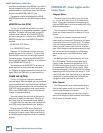
24
Compact Mixer Reference Guide
MIXER ANATOMY: CHAPTER 2
AUX Send Shift
Some Mackie consoles have six AUX SEND busses
but only four AUX knobs. The SHIFT button selects
whether their associated knobs send the channel
signal to AUX outputs 3 and 4 or outputs 5 and 6 on a
channel-by-channel basis.
Using AUXes with Effects
Here’s the signal fl ow from the AUX send, through
the AUX output, to a reverb unit, and back to the mix
through the AUX Return jack.
This is sometimes called a “parallel” effect con-
nection, since the path of the processed signal is in
parallel with the dry signal path.
Built-in Effects
The CFX, DFX. and PPM series mixers have a built
in digital effects processor (EMAC). The input of the
EMAC is normally connected to the EFX bus (EFX
2 in the CFX), and the output is normally returned
to the MAIN bus. The EFX send and return jacks on
these mixers have normalling switch contacts – in-
serting a plug disconnects the normal send/return
loop through the EMAC so that you can use them
with an outboard processor.
With some clever cable juggling you can even
use the EMAC processor as an outboard effect for
another mixer.
EFX Foot Switch and Bypass
We’ve included some features on the effects-
equipped mixers that will be welcomed by the
musician or band working without a sound engineer.
The Grand Canyon reverb might have sounded great
on that ballad you just fi nished, but it really sounds
dumb on your speaking voice, when you’re introduc-
ing the next song. It’s handy to be able to quickly kill
the effects processor and then turn it back on when
it’s time for the next song.
The EFX BYPASS switch on the front panel mutes
the signal to the effects processor when you’re in
easy reach of the mixer. By plugging a normally open,
latching (push-on-push-off) foot switch into the
EFX FOOT SWITCH jack, you can mute the effect
return without leaving your performing position. If
the mixer is in sight, the lighted EFX BYPASS LED
will remind you of why you’re no longer in the Grand
Canyon.
If you’re using an outboard effects pro-
cessor on the PPM instead of the EMAC,
that will also be bypassed when either the
front panel or foot switch is activated. On the CFX
and DFX, however, the bypass switch comes ahead of
the EFX RETURN 2 jacks, so an external processor
coming in to the mix at that point will not be affected
by the bypass foot switch.
Plugging in a foot switch disables the
front panel EFX BYPASS switch.
Control Room Output
When recording, it’s convenient to have an output
with its own volume control that’s dedicated to con-
trol room listening. Control Room outputs are on 1/4"
balanced TRS jacks (unbalanced on the 8-Bus) and
are fed from the Control Room Level control. This al-
lows you to crank the playback level so the drummer
can hear it, or turn it down to answer the telephone,
all without disturbing the MASTER level, which
you’ve set to send the proper level to the mixdown
recorder.
The source for the Control Room output is selected
by switches in the Master section of the console. The
Main left/right outputs are always available to the
control room monitor. Other choices, depending on
the mixer, are the subgroups, ALT 3-4 bus, playback
from a stereo recorder, Mix B, or another external
source such as a CD player.
Headphone Output
The Headphone output is another copy of the
Control Room output (the 8-Bus offers several other
choices) followed by an amplifi er capable of driving a
set of headphones to a comfortable, no, a pretty darn
loud level.
WARNING: When we say the headphone
amp is loud, we’re not kidding. It can
cause permanent hearing damage (and
headphone damage, too). Even intermediate levels
may be painfully loud with some earphones. BE
CAREFUL!
•
•
•
•
•
•
•
•
FA DE R
AUX
AUX
BUS
AUX
SEND
AUX
RETURN
MAIN
BUS
REVERB
IN
OUT
















